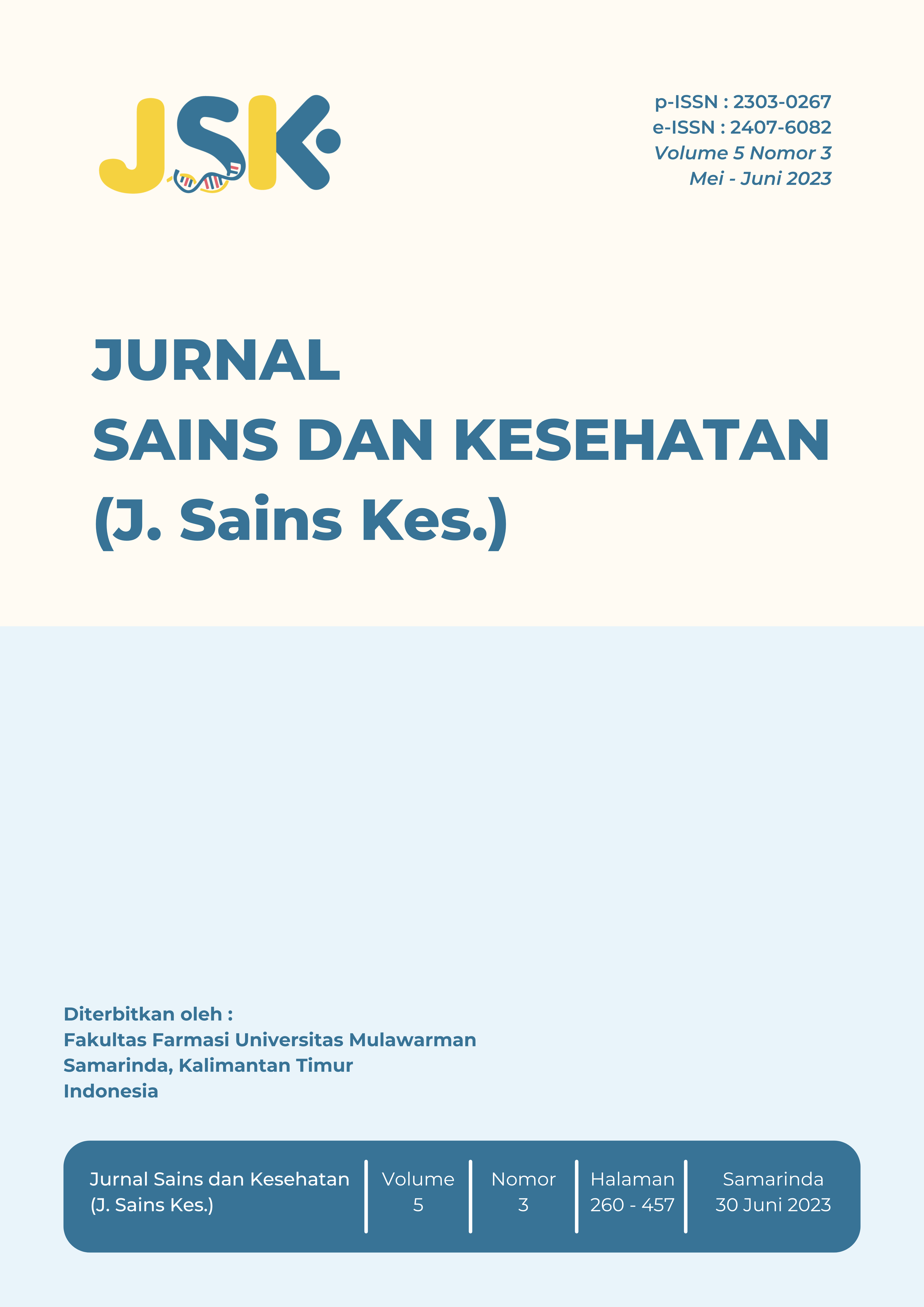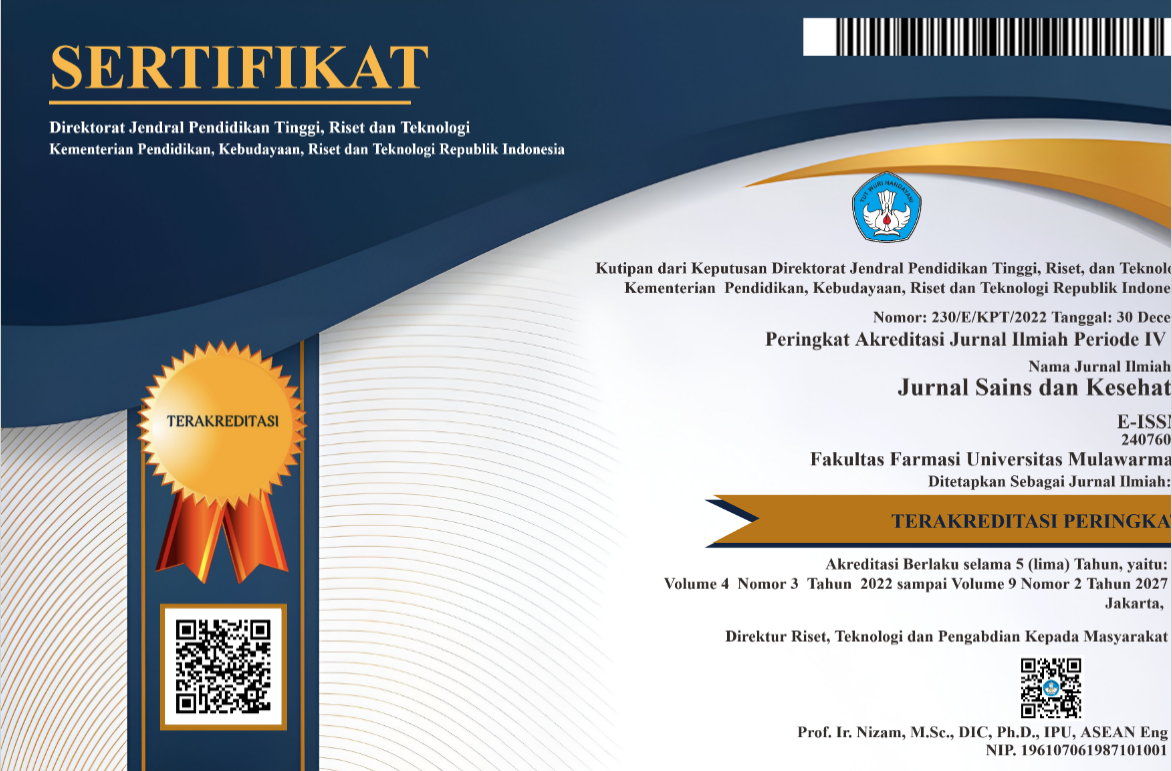Penggunaan Agen Pengendap terhadap Pengendapan Lantanum dan Neodimium
Use of Precipitating Agents against the Precipitation of Lanthanum and Neodymium
Keywords:
Logam Tanah Jarang, Monasit, Pengendapan, Agen PengendapAbstract
References
M. Anggraini, Sumarni, Sumiarti, R. S, and S. W, “Pengendapan Unsur Tanah Jarang Hasil Digesti Monasit Bangka Menggunakan Asam Sulfat,” vol. 33, no. 2, pp. 121–128, 2012.
B. Bauer, D; Diamond, D; Li, J; Sandalow, D; Telleen, P; Wanner, “U.S. Department of Energy Critical Materials Strategy,” Lancet Neurol., 2010, doi: 10.1016/S1474-4422(13)70033-4.
R. L. Moss, E. Tzimas, H. Kara, P. Willis, and J. Kooroshy, “The potential risks from metals bottlenecks to the deployment of Strategic Energy Technologies,” Energy Policy, vol. 55, pp. 556–564, 2013, doi: 10.1016/j.enpol.2012.12.053.
J. C. B. S. Amaral and C. A. Morais, “Thorium and uranium extraction from rare earth elements in monazite sulfuric acid liquor through solvent extraction,” Miner. Eng., vol. 23, no. 6, pp. 498–503, 2010, doi: 10.1016/j.mineng.2010.01.003.
E. M. Abu Elgoud, Z. H. Ismail, M. I. Ahmad, Y. A. El-Nadi, S. M. Abdelwahab, and H. F. Aly, “Sorption of Lanthanum(III) and Neodymium(III) from Concentrated Phosphoric Acid by Strongly Acidic Cation Exchange Resin (SQS-6),” Russ. J. Appl. Chem., vol. 92, no. 11, pp. 1581–1592, 2019, doi: 10.1134/S1070427219110156.
L. Zhao et al., “The Pharmacological Effect and Mechanism of Lanthanum Hydroxide on Vascular Calcification Caused by Chronic Renal Failure Hyperphosphatemia,” Front. Cell Dev. Biol., vol. 9, no. April, pp. 1–16, 2021, doi: 10.3389/fcell.2021.639127.
C. Yüksel, “The Use of Neodymium Magnets in Healthcare and Their Effects on Health,” North. Clin. Istanbul, vol. 5, no. 3, pp. 268–273, 2017, doi: 10.14744/nci.2017.00483.
A. P. Colbert et al., “Static magnetic field therapy: A critical review of treatment parameters,” Evidence-based Complement. Altern. Med., vol. 6, no. 2, pp. 133–139, 2009, doi: 10.1093/ecam/nem131.
H. LN, F. R, S. W, B. S, A. S, and Susilaningtyas, “Pengolahan Monasit Dari Limbah Penambangan Timah: Pemisahan Logam Tanah Jarang (RE) Dari U dan Th,” Pros. Present. Ilm. Daur Bahan Bakar Nukl. V, pp. 54–60, 2000.
Arianto, H. Sosidi, Prismawiryanti, and D. J. Pusptasari, “Pemisahan Logam Tanah Jarang dari Limbah (Tailing) Emas Poboya dengan Metode Pengendapan,” KOVALEN J. Ris. Kim., vol. 6, no. 1, pp. 9–17, 2020, doi: 10.22487/kovalen.2020.v6.i1.13861.
K. N. Han, “Characteristics of precipitation of rare earth elements with various precipitants,” Minerals, vol. 10, no. 2, 2020, doi: 10.3390/min10020178.
A. Alemayehu, A. Zakharanka, and V. Tyrpekl, “Homogeneous Precipitation of Lanthanide Oxalates,” ACS Omega, vol. 7, no. 14, pp. 12288–12295, 2022, doi: 10.1021/acsomega.2c00763.
R. G. Silva, C. A. Morais, L. V. Teixeira, and É. D. Oliveira, “Selective Precipitation of High-Quality Rare Earth Oxalates or Carbonates from a Purified Sulfuric Liquor Containing Soluble Impurities,” Mining, Metall. Explor., vol. 36, no. 5, pp. 967–977, 2019, doi: 10.1007/s42461-019-0090-6.
M. L. Strauss, “The Recovery of Rare Earth Oxides From Waste Fluorescent of Mines,” Color. Sch. Mines, 2016.
D. Beltrami, G. J. P. Deblonde, S. Bélair, and V. Weigel, “Recovery of yttrium and lanthanides from sulfate solutions with high concentration of iron and low rare earth content,” Hydrometallurgy, vol. 157, pp. 356–362, 2015, doi: 10.1016/j.hydromet.2015.07.015.
J.-H. Chung, Dong-Yong; Kim, Eung-Ho; Lee, Eil-Hee; Yoo, “Solubility of RE oxalate in oxalic and nitric acid media.” pp. 277–284, 1998. [Online]. Available: https://www.cheric.org/research/tech/periodicals/view.php?seq=12719
J. S. Kim, H. soo Kim, M. J. Kim, J. Lee, and J. R. Kumar, “Status of Separation and Purification of Rare Earth Elements from Korean Ore,” Rare Met. Technol. 2015, pp. 117–118, 2015, doi: 10.1007/978-3-319-48188-3.
A. Nawab, X. Yang, and R. Honaker, “Parametric study and speciation analysis of rare earth precipitation using oxalic acid in a chloride solution system,” Miner. Eng., vol. 176, 2022, doi: 10.1016/j.mineng.2021.107352.
S. H. Ahmed, O. S. Helaly, and M. S. Abd El-Ghany, “Preliminary Study for Separation of Heavy Rare Earth Concentrates from Egyptian Crude Monazite,” World Acad. Sci. Eng. Technol. Int. J. Mater. Metall. Eng., vol. 8, no. 8, p. 7, 2014.
D. Rattanaphra, O. Leelanupat, and U. Suwanmanee, “Purification Process of Lanthanum and Neodymium from Mixed Rare Earth,” Pure Appl. Chem. Int. Conf. 2013, no. July, 2016.
F. Sadri, F. Rashchi, and A. Amini, “Hydrometallurgical digestion and leaching of Iranian monazite concentrate containing rare earth elements Th, Ce, La and Nd,” Int. J. Miner. Process., vol. 159, pp. 7–15, 2017, doi: 10.1016/j.minpro.2016.12.003.
M. S. Archambo and S. K. Kawatra, “Extraction of Rare Earths from Red Mud Iron Nugget Slags with Oxalic Acid Precipitation,” Miner. Process. Extr. Metall. Rev., vol. 43, no. 5, pp. 656–663, 2022, doi: 10.1080/08827508.2021.1927729.
S. Jaireth, D. M. Hoatson, and Y. Miezitis, “Geological setting and resources of the major rare-earth-element deposits in Australia,” Ore Geol. Rev., vol. 62, pp. 72–128, 2014, doi: 10.1016/j.oregeorev.2014.02.008.
M. V. Purwani, K. Trinopiawan, H. Poernomo, Suyanti, N. D. Pusporini, and R. A. Amiliana, “Separation of Ce, la and Nd in rare earth hydroxide (REOH) by oxidation with potassium permanganate and precipitation,” J. Phys. Conf. Ser., vol. 1198, no. 3, 2019, doi: 10.1088/1742-6596/1198/3/032003.
Aung Myint Wai, “Selective Precipitation of Neodymium oxide (Nd2O3) from Monazite,” Int. J. Sci. Eng. Technol. Res., vol. 7, no. 8, pp. 2278–7798, 2018.
T. Sofyatin, D. Hendrati, and U. Pratomo, “Indonesian Chemia Acta Pengendapan Melalui Destruksi Menggunakan Akua Regia,” Indones. Chem. Acta, vol. 6, no. 1, pp. 25–29, 2016.
Samin, Suyanti, S. T. Sunanti, and W. A. Adi, “Synthesis and certification of lanthanum oxide extracted from monazite sand,” Indones. J. Chem., vol. 20, no. 6, pp. 1213–1220, 2020, doi: 10.22146/ijc.44327.
S. R. Lim, S. D. Lee, H. S. Kim, F. S. H. Simanjuntak, and H. Lee, “Lanthanum oxide-catalyzed transesterification of dimethyl carbonate with glycerol: Effect of surfactant,” Bull. Korean Chem. Soc., vol. 35, no. 11, pp. 3163–3168, 2014, doi: 10.5012/bkcs.2014.35.11.3163.
C. H. Lee, Y. C. Lo, N. Sandagdorj, E. Gankhuyag, S. R. Popuri, and C. E. Hung, “Recycling of Cerium and Lanthanum from Glass Polishing Sludge,” Polish J. Chem. Technol., vol. 21, no. 4, pp. 26–30, 2019, doi: 10.2478/pjct-2019-0035.
P. Kim, A. Anderko, A. Navrotsky, and R. E. Riman, “Trends in structure and thermodynamic properties of normal rare earth carbonates and rare earth hydroxycarbonates,” Minerals, vol. 8, no. 3, 2018, doi: 10.3390/min8030106.
L. Wang, X. Huang, Y. Yu, and Z. Long, “Kinetics of rare earth pre-loading with 2-ethylhexyl phosphoric acid mono 2-ethylhexyl ester [HEH(EHP)] using rare earth carbonates,” Sep. Purif. Technol., vol. 122, pp. 490–494, 2014, doi: 10.1016/j.seppur.2013.12.007.
M. E. El-Awady, A. I. L. Abd-Elfatah, S. M. Abd-Elwahab, A. H. Mahmoud, and O. S. Helaly, “Selective Precipitation of Yttrium from Monazite Acid Leach Liquor by Using Carbonates Precipitation Method.,” Bull. Tabbin Inst. Metall. Stud., vol. 108, no. 1, pp. 30–39, 2019, doi: 10.21608/tims.2019.190142.
F. Sadri, A. M. Nazari, and A. Ghahreman, “A review on the cracking, baking and leaching processes of rare earth element concentrates,” J. Rare Earths, vol. 35, no. 8, pp. 739–752, 2017, doi: 10.1016/S1002-0721(17)60971-2.
Downloads
Published
Issue
Section
Deprecated: json_decode(): Passing null to parameter #1 ($json) of type string is deprecated in /home/jskff/public_html/plugins/generic/citations/CitationsPlugin.php on line 68
How to Cite
Most read articles by the same author(s)
- Juliana Puteri, Anni Anggraeni, Ari Hardianto, Husein H. Bahti, Oksidasi Serium Berdasarkan Agen Pengoksidasi , Jurnal Sains dan Kesehatan: Vol. 5 No. 3 (2023): J. Sains Kes.
- Senadi Budiman, Husein H. Bahti, Anni Anggraeni, Pemisahan Gadolinium Sebagai Contrast Agent Pada MRI (Magnetic Resonance Imaging) dengan Ligan Asam Di-(2-Etilheksil)Fosfat (D2EHPA) dan Tributilfosfat (TBP) Secara Ekstraksi Cair-Cair dengan Pelarut Organik-Kerosin , Jurnal Sains dan Kesehatan: Vol. 1 No. 9 (2018): J. Sains Kes.
Similar Articles
- Juliana Puteri, Anni Anggraeni, Ari Hardianto, Husein H. Bahti, Oksidasi Serium Berdasarkan Agen Pengoksidasi , Jurnal Sains dan Kesehatan: Vol. 5 No. 3 (2023): J. Sains Kes.
- Senadi Budiman, Husein H. Bahti, Anni Anggraeni, Pemisahan Gadolinium Sebagai Contrast Agent Pada MRI (Magnetic Resonance Imaging) dengan Ligan Asam Di-(2-Etilheksil)Fosfat (D2EHPA) dan Tributilfosfat (TBP) Secara Ekstraksi Cair-Cair dengan Pelarut Organik-Kerosin , Jurnal Sains dan Kesehatan: Vol. 1 No. 9 (2018): J. Sains Kes.
- Sabaniah Indjar Gama, Analisis Logam Berat Dalam Daun Sirsak dan Daun Beluntas , Jurnal Sains dan Kesehatan: Vol. 1 No. 8 (2017): J. Sains Kes.
- Oktavia Sari, Eriko Prawestiningtyas, Tes Takayama sebagai Sarana Identifikasi Sampel Darah Terpapar Media Dekomposisi Tanah , Jurnal Sains dan Kesehatan: Vol. 4 No. 3 (2022): J. Sains Kes.
- Mia Audina Curnia Safitri, Amalia Eka Putri, Dara Pranidya Tilarso, Uji Aktivitas Antibakteri Fraksi Batang Pepaya (Carica papaya Linn.) terhadap Bakteri Escherichia coli ATCC 25922 Secara In Vitro , Jurnal Sains dan Kesehatan: Vol. 2 No. 4 (2020): J. Sains Kes.
- Fatimah Az-Zhahra, Nisa Naspiah, Lizma Febrina, Rolan Rusli, Sintesis Nanopartikel Perak Menggunakan Ekstrak Metanol Daun Nipah (Nypa fruticans) sebagai Agen Antibakteri , Jurnal Sains dan Kesehatan: Vol. 2 No. 3 (2020): J. Sains Kes.
- Muhammad Khairul Nuryanto, Swandari Paramita, Abdillah Iskandar, Sjarif Ismail, Andre Kusuma Ruslim, Aktivitas Anti-Inflamasi In Vitro Ekstrak Etanol Daun Vernonia amygdalina DELILE Dengan Pengujian Stabilisasi Membran , Jurnal Sains dan Kesehatan: Vol. 1 No. 8 (2017): J. Sains Kes.
- Aulya Rahma Fadilah, Portuna Putra Kambaya, Nydia Hanan, Distribusi Pencabutan Gigi Akibat Karies Berdasarkan Karakteristik Sosiodemografi pada Pasien Poli Gigi Puskesmas Tanah Grogot Tahun 2017-2019 , Jurnal Sains dan Kesehatan: Vol. 4 No. 2 (2022): J. Sains Kes.
- Fendi Yoga Wardana, Vita Mariah, Analisis Kandungan Natrium Siklamat pada Jamu Sinom di Pasar Besar Malang , Jurnal Sains dan Kesehatan: Vol. 5 No. 5 (2023): J. Sains Kes.
- Nurul Handayani, Muhammad Faisal, Rolan Rusli, Kajian Interaksi Obat pada Pasien Gagal Ginjal Rawat Inap di RSUD Panglima Sebaya Tanah Grogot , Jurnal Sains dan Kesehatan: Vol. 5 No. 4 (2023): J. Sains Kes.
You may also start an advanced similarity search for this article.




